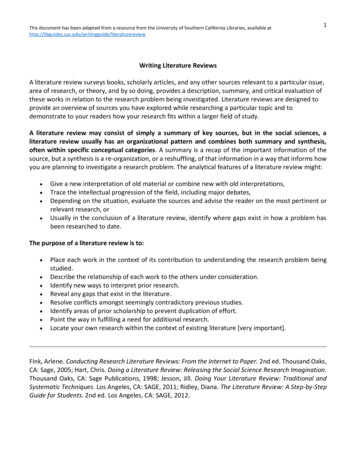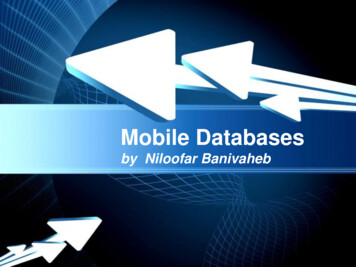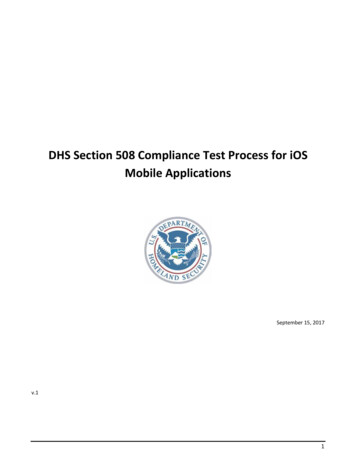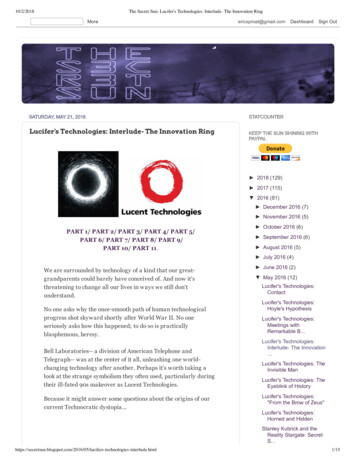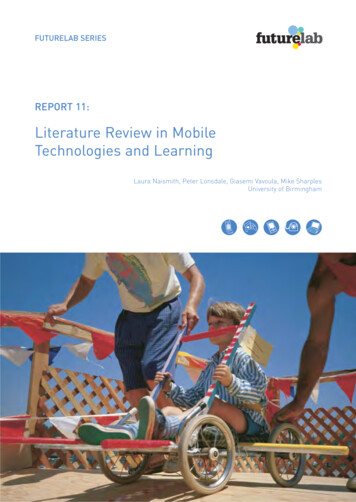
Transcription
FUTURELAB SERIESREPORT 11:Literature Review in MobileTechnologies and LearningLaura Naismith, Peter Lonsdale, Giasemi Vavoula, Mike SharplesUniversity of Birmingham
FUTURELAB SERIESCONTENTS:REPORT 11:Literature Review in MobileTechnologies and LearningLaura Naismith, Peter Lonsdale, Giasemi Vavoula, Mike SharplesUniversity of BirminghamFOREWORDMobile technologies are a familiar part ofthe lives of most teachers and studentsin the UK today. We take it for grantedthat we can talk to other people at anytime, from wherever we may be; we arebeginning to see it as normal that we canaccess information, take photographs,record our thoughts with one device, andthat we can share these with our friends,colleagues or the wider world. Newerdevelopments in mobile phone technologyare also beginning to offer the potentialfor rich multimedia experiences and forlocation-specific resources.The challenge for educators anddesigners, however, is one ofunderstanding and exploring how bestwe might use these resources to supportlearning. That we need to do this isclear – how much sense does it maketo continue to exclude from schools,powerful technologies that are seen asa normal part of everyday life? At thepresent time, however, the models forusing and developing mobile applicationsfor learning are somewhat lacking.This review provides a rich vision ofthe current and potential futuredevelopments in this area. It movesaway from the dominant view of mobilelearning as an isolated activity to exploremobile learning as a rich, collaborativeand conversational experience, whetherin classrooms, homes or the streets ofa city. It asks how we might draw onexisting theories of learning to help usevaluate the most relevant applicationsof mobile technologies in education. Itdescribes outstanding projects currentlyunder development in the UK and aroundthe world and it explores what the futuremight hold for learning with mobiletechnologies.EXECUTIVE SUMMARY2SECTION 1INTRODUCTION6SECTION 2AN ACTIVITY-BASEDAPPROACH TO CONSIDERINGLEARNING WITHMOBILE TECHNOLOGIES9SECTION 3TEACHING ANDLEARNING WITH MOBILETECHNOLOGIES –CASE STUDIES20SECTION 4IMPLICATIONS FORLEARNERS, TEACHERSAND TECHNOLOGYDEVELOPERS33SECTION 5THE FUTURE OF TEACHINGAND LEARNING WITHMOBILE TECHNOLOGIES36BIBLIOGRAPHY37APPENDIX 1CHARACTERISTICS OFMOBILE TECHNOLOGIES42APPENDIX 2MAJOR MOBILE LEARNINGRESEARCH PROJECTS42We look forward to hearing your viewson this review and welcome commentsat info@futurelab.org.ukKeri FacerDirector of Learning ResearchFuturelab1
EXECUTIVE SUMMARYEXECUTIVE SUMMARYThe whole world is going mobile. Phones,computers and media devices now fit inour pockets and can connect us to avariety of information sources and enablecommunication nearly everywhere wego. There is considerable interest inexploiting the almost universal appealand abundance of these technologies fortheir educational use.the whole worldis going mobileThe following issues are the most salient:WHAT ARE THE NEW MOBILETECHNOLOGIES, AND WHY ARETHEY RELEVANT TO LEARNING?With respect to technologies, ‘mobile’generally means portable and personal,like a mobile phone. Many examples oflearning with mobile technologies fit into this description. Personal digitalassistants and mobile phones are themost commonly used technologies formobile learning, but they exist withinthe larger space of possible mobiletechnologies that can be broadlycategorised on the two dimensions ofpersonal vs shared and portable vs static.NEW LEARNING AND TEACHINGPRACTICES AND MOBILETECHNOLOGIESMost previous reviews of mobiletechnologies and learning have beenconcerned with the use of thesetechnologies to address specificcurriculum areas. In this review, wetake an activity-centred perspective,considering new practices against2existing theories. Our review of theliterature reveals six broad theory-basedcategories of activity, and identifies anumber of examples of the use of mobiletechnology in each of them:1 Behaviourist – activities that promotelearning as a change in learners’observable actionsIn the behaviourist paradigm, learningis thought to be best facilitated throughthe reinforcement of an associationbetween a particular stimulus and aresponse. Applying this to educationaltechnology, computer-aided learning isthe presentation of a problem (stimulus)followed by the contribution on the partof the learner of the solution (response).Feedback from the system then providesthe reinforcement. In a mobile learningcontext, classroom response systemslike ‘Classtalk’ (Dufresne et al 1996) and‘Qwizdom’ (Qwizdom: Assessment forLearning in the Classroom 2003) fall inthis category, as well as examples ofcontent delivery by text messages tomobile phones (BBC Bitesize 2003,2004; Thornton and Houser 2004).2 Constructivist – activities in whichlearners actively construct new ideas orconcepts based on both their previousand current knowledgeIn the constructivist approach, learningis an active process in which learnersconstruct new ideas or concepts basedon both their current and pastknowledge. Learners are encouragedto be active constructors of knowledge,with mobile devices now embeddingthem in a realistic context at the sametime as offering access to supportingtools. The most compelling examplesof the implementation of constructivistprinciples with mobile technologies
REPORT 11LITERATURE REVIEW IN MOBILE TECHNOLOGIES AND LEARNINGLAURA NAISMITH, PETER LONSDALE, GIASEMI VAVOULA, MIKE SHARPLES, UNIVERSITY OF BIRMINGHAMcome from a brand of learningexperience termed ‘participatorysimulations’, where the learnersthemselves act out key parts in animmersive recreation of a dynamicsystem. Examples include the VirusGame (Collella 2000), Savannah(Facer et al in preparation), and theEnvironmental Detectives (Klopferand Squire in preparation).3 Situated – activities that promotelearning within an authentic contextand cultureSituated learning posits that learningcan be enhanced by ensuring that ittakes place in an authentic context.Mobile devices are especially well suitedto context-aware applications simplybecause they are available in differentcontexts, and so can draw on thosecontexts to enhance the learning activity.The museum and gallery sector hasbeen on the forefront of context-awaremobile computing by providingadditional information about exhibitsand displays based on the visitor’slocation within them. Examples ofmobile systems that situate learning inauthentic contexts include the AmbientWood (Rogers et al 2002), MOBIlearn(Lonsdale et al 2003, 2004), and themultimedia tours offered at the TateModern (Proctor and Burton 2003).4 Collaborative – activities that promotelearning through social interactionCollaborative learning has sprung outfrom research on computer-supportedcollaborative work and learning(CSCW/L) and is based on the role ofsocial interactions in the process oflearning. Many new approaches tothinking about learning developed inthe 1990s, most of which are rootedin Vygotsky’s socio-cultural psychology(Vygotsky 1978), including activity theory(see for example Engeström 1987).Though not traditionally linked withcollaborative learning, another theorythat is particularly relevant to ourconsideration of collaboration usingmobile devices is conversation theory(Pask 1976), which describes learningin terms of conversations betweendifferent systems of knowledge. Mobiledevices can support mobile computersupported collaborative learning(MCSCL) by providing another means ofcoordination without attempting toreplace any human-human interactions,as compared to say, online discussionboards which substitute for face-to-facediscussions (Zurita et al 2003; Cortez etal 2004; Zurita and Nussbaum 2004).5 Informal and lifelong – activitiesthat support learning outside adedicated learning environmentand formal curriculumResearch on informal and lifelonglearning recognises that learninghappens all of the time and isinfluenced both by our environment andthe particular situations we are facedwith. Informal learning may beintentional, for example, throughintensive, significant and deliberatelearning ‘projects’ (Tough 1971), orit may be accidental, by acquiringinformation through conversations, TVand newspapers, observing the worldor even experiencing an accident orembarrassing situation. Such a broadview of learning takes it outside theclassroom and, by default, embedslearning in everyday life, thusemphasising the value of mobiletechnologies in supporting it. Anexample in this category is the systemmobile devicesare especiallywell suited tocontext-awareapplications3
EXECUTIVE SUMMARYdescribed by Wood et al (2003) wherebreast cancer patients are enabled toaccess trustworthy information abouttheir condition, to communicate withother patients, and to keep track ofthe issues that concern them.6 Learning and teaching support –activities that assist in the coordinationof learners and resources for learningactivitiesEducation as a process relies on agreat deal of coordination of learnersand resources. Mobile devices can beused by teachers for attendancereporting, reviewing student marks,general access of central school data,and managing their schedules moreeffectively. In higher education, mobiledevices can provide course materialto students, including due dates forassignments and information abouttimetable and room changes. Examplesof using mobile technologies in thiscontext include a mobile learningorganiser which has been developed andtested at the University of Birmingham(Holme and Sharples 2002; Sharples etal 2003; Corlett et al 2004), and the useof mobile phone technologies to supportcomputing students (Riordan andTraxler 2003; Traxler and Riordan 2003).a blendedapproach toenabling learningwith mobiletechnologies isnecessary4A blended approach to enabling learningwith mobile technologies is necessary assuccessful and engaging activities drawon a number of different theories andpractices.WHAT ARE THE IMPLICATIONSFOR LEARNERS, TEACHERS ANDCURRICULUM DEVELOPERS?Learning and teaching with mobiletechnologies is beginning to make abreakthrough from small-scale pilotsto institution-wide implementations. Inorder for these implementations to besuccessful, educators and technologydevelopers must consider the followingkey issues: Context: gathering and utilisingcontextual information may clash withthe learner’s wish for anonymity andprivacy. Mobility: the ability to link to activities inthe outside world also provides studentswith the capability to ‘escape’ theclassroom and engage in activities thatdo not correspond with either theteacher’s agenda or the curriculum. Learning over time: effective tools areneeded for the recording, organisationand retrieval of (mobile) learningexperiences. Informality: students may abandontheir use of certain technologies if theyperceive their social networks to beunder attack. Ownership: students want to own andcontrol their personal technology, butthis presents a challenge when theybring it in to the classroom.Research-informed guidelines can help toaddress these issues along with morepractical concerns such as cost, usability,technical and institutional support. A setof such guidelines (O’Malley et al 2003) ispresented in Section 4.1 and outlined here:
1 Investigate a cost model forinfrastructure, technology and services.WHAT IS THE FUTURE OF MOBILETECHNOLOGY IN EDUCATION?2 Study the requirements of all thoseinvolved in the use of the technology(learners, teachers, content creators)to ensure it is usable and acceptable.Mobile technologies are becoming moreembedded, ubiquitous and networked,with enhanced capabilities for rich socialinteractions, context awareness andinternet connectivity. Such technologiescan have a great impact on learning.Learning will move more and more outsideof the classroom and into the learner’senvironments, both real and virtual, thusbecoming more situated, personal,collaborative and lifelong. The challengewill be to discover how to use mobiletechnologies to transform learning intoa seamless part of daily life to the pointwhere it is not recognised as learning at all.3 Assess that the technology is suitedto the learning task and examineadvantages and disadvantages of eachtechnology before making a decision onwhich one to use.4 Assign the necessary roles for initiatingand thereafter supporting mobilelearning.5 Develop procedures and strategies forthe management of equipment when itis provided by the institution.learning andteaching withmobiletechnologiesis beginningto make abreakthrough6 Provide training and (ongoing) technicalsupport to the teachers to enable themto use mobile technologies to enhancecurrent and to enable new instructionalactivities.7 Consider the use of mobile technologiesfor student administration tasks.8 Consider the use of mobile technologiesto support collaborative and grouplearning.9 Discover and adopt suitable applicationsthat match the needs of your specificclassroom and map directly to yourcurriculum needs.10 Ensure security and privacy for theend users.5
SECTION 1INTRODUCTION1 INTRODUCTIONToday we are witnessing the emergence ofa connected, mobile society, with a varietyof information sources and means ofcommunication available at home, work,school and in the community at large.Some even describe this as the beginningof the next social revolution (for example,Rheingold 2003). A high proportion of UKresidents have mobile phones (75%general population, 90% young adults;Crabtree et al 2003) that can handle bothvoice calls and the display of textualinformation. Many newer phones also havethe ability to connect wirelessly to theinternet. Hand-held computers, otherwiseknown as personal digital assistants(PDAs), are also becoming morewidespread (BBC 2004), being distributedby employers who are eager to keep theirworkforce productive whilst on the move.Laptops, though already a well-establishedtechnology, have gained new appeal whencombined with the connectivity of newermobile phones – a laptop can now use amobile phone as a means to dial-up theinternet and in doing so offer a trulymobile web experience. Furthermore,kiosks and information screens areappearing all around the country, andboth researchers and industry arekeen to exploit the potential of these‘ambient’ approaches to providing richinformation spaces.There is considerable interest fromeducators and technical developers inexploiting the unique capabilities andcharacteristics of mobile technologies toenable new and engaging forms oflearning. This review explores the use ofthese mobile technologies for learning,considered against a backdrop of existinglearning theories that have been applied to6the use of computers in education.The specific aims of this review are: to identify the different types of mobiletechnologies that are applicable tolearning to explore new and emerging practicesrelating to the use of mobiletechnologies for learning to identify the learning theories that arerelevant to these new practices to present a set of exemplary casestudies demonstrating uses of mobiletechnologies for learning to present key issues and guidelines toinform current educational practice andpolicy to encourage educators and technicaldevelopers to rethink their roles for thefuture of learning with mobiletechnologies.1.1 MOTIVATION FOR THIS REVIEWThe prevalence of mobile technologies isin itself a motivator to exploit them forlearning. Mobile technologies are alreadywidespread among children (NOP 2001).It makes sense, then, for an educationalsystem with limited information andcommunication technology (ICT) resourcesto make the most of what children bring tothe classroom. Sharples (2003) suggeststhat rather than seeing them as disruptivedevices, educators should seek to exploitthe potential of the technologies childrenbring with them and find ways to put theminto good use for the benefit of learningpractice. Mobile technologies provide anopportunity for a fundamental change ineducation away from occasional use of acomputer in a lab towards more embedded
use in the classroom and beyond(Hennessy 1999). Soloway et al (2001) havefurther argued that to make any differencein the classroom at all, computers must bemobile and within ‘arm’s reach’.The nature of learning is closely linkedto the concept of mobility. Vavoula andSharples (2002) suggest that there arethree ways in which learning can beconsidered mobile:“learning is mobile in terms of space, ie ithappens at the workplace, at home, and atplaces of leisure; it is mobile betweendifferent areas of life, ie it may relate towork demands, self-improvement, orleisure; and it is mobile with respect totime, ie it happens at different timesduring the day, on working days or onweekends” (p152).The close relation of learning to thecontext and the situation in which thelearning need arises has been widelydiscussed in the literature (Brown et al1989; Lave and Wenger 1991) and thebenefits of just-in-time, situated learninghave been explored (Goodyear 2000). Nyiri(2002) notes that knowledge is informationin context and since mobile devices enablethe delivery of context-specific informationthey are well placed to enable learning andthe construction of knowledge.Mobile technologies offer learningexperiences which can effectively engageand educate contemporary learners andwhich are often markedly different fromthose afforded by conventional desktopcomputers. These devices are useddynamically, in many different settings,giving access to a broad range of uses andsituated learning activities. The personalnature of these technologies means thatthey are well suited to engaging learnersin individualised learning experiences, andto giving them increased ownership (andhence responsibility) over their own work.Most previous reviews of mobiletechnologies for learning categoriseexamples of use according to curriculumarea. We believe that the benefits of mobiletechnologies for learning encompass morethan just what an individual can do with adevice, and that there is thus a need fora wider review of new and emergingpractices and how these relate to theoriesand paradigms previously established forthe use of computers in education.1.2 CLASSIFICATION OF MOBILETECHNOLOGIESThere are many different kinds oftechnology that can be classed as ‘mobile’.Mobile, to most, means ‘portable’ and‘movable’. It also seems to implicate a‘personal’ as opposed to ‘shared’ contextof use, and the terms ‘mobile’ and‘personal’ are often used interchangeably –but a device might be one withoutnecessarily being the other.We can classify the range of mobiletechnologies using the two orthogonal1Gamesconsoles2PersonalMobile phonesPDAsTablet PCsClassroomresponse sElectronicwhiteboardsShared34Fig 1: Classification of mobile technologies7
SECTION 1INTRODUCTIONdimensions of personal vs shared andportable vs static, as outlined in Fig 1.Quadrant 1 shows devices that can beclassified as both portable and personal.These kinds of devices are what peoplemost commonly think of in relation tomobile technologies: mobile phones,PDAs, tablet PCs and laptops. It alsoincludes hand-held video game consoles,with Rosas et al (2003) and Lee et al (2004)reporting on early evaluations of theireducational use. Since these devicesnormally support a single user, they aregenerally perceived as being very personal.The networked nature of such devicesaffords communication and informationsharing, meaning that while the devicesthemselves are personal, the informationwithin them can be shared easily. Thesedevices are portable because they aretaken from place to place and hencethey can be available in many differentlocations. These are personal portabletechnologies.on the move, but the devices themselvesare not physically movable. Street kiosks,interactive museum displays and otherkinds of installations offer pervasiveaccess to information and learningexperiences, but it is the learner who isportable, not the delivery technology. Suchdevices are typically seen as being lesspersonal, and are likely to be sharedbetween multiple users. Their larger sizemeans they are also better suited tomultiple-user interactions. These areshared portable technologies.Some other technologies, less portablethan mobile phones and PDAs, can stilloffer personal interactions with learningexperiences. Classroom response systems,shown in quadrant 2, consist of individualstudent devices that are used to respondanonymously to multiple choice questionsadministered by a teacher on a centralserver. This technology is static in thesense that it can only be used in onelocation, but remains personal because ofits small size and allocation to (typically)one single user. These are personal statictechnologies.We believe that ‘mobile technologies’comprise all devices from quadrants 1-3,and those from quadrant 4 that are not atthe extreme end of the ‘static’ dimension.Being physically moved from one place toanother is not the only way in which mobiletechnologies can be ‘portable’. In quadrant3, there are examples of technologies thatcan provide learning experiences to users8For more shareable interactions, thedevices themselves must become largerand hence less portable. Examples includeinteractive classroom whiteboards andvideo-conferencing facilities, as shownin quadrant 4. These technologies havebeen included to show the completespace of possibilities engendered by ourclassification, but they would generallynot be classed as mobile technologies.1.3 SCOPE OF THIS REVIEWIn this review we will primarily beconsidering personal portabletechnologies. We shall focus onhand-held devices including PDAs andmobile phones. Many of the implicationsfor learning are shared by otherportable devices such as tablet PCsand laptops.Even within the narrow range of devicesconsidered there is a variety of capabilitiesand features. Appendix 1 presents an
SECTION 2AN ACTIVITY-BASED APPROACH TO CONSIDERINGLEARNING WITH MOBILE TECHNOLOGIESoverview of features and specifications.Further discussion of mobile devicecharacteristics can be found in Sharplesand Beale (2003) and Becta (2004).This review advocates an activity-focusedperspective on the use of mobiletechnologies for education, and presentsthese activities along with relevantlearning paradigms and theories in Section2. In Section 3, we illustrate the categoriesof practice through case studies drawnfrom the literature. In Section 4, weconsider the implications for policy andeducational practice, and presentresearch-informed guidelines as to howthese can be addressed. Finally, withreference to both emerging trends inmobile technology and learning research,we speculate on the future of mobiletechnologies and learning and theimplications this will have for today’seducators and technology developers.2 AN ACTIVITY-BASED APPROACHTO CONSIDERING LEARNING WITHMOBILE TECHNOLOGIESMuch of the research into the use ofmobile technologies for learning is drivenby the technical capabilities of newdevices. This is not unexpected, given therapidly changing face of mobile computing.These new capabilities inspire newpractices which can lead to valuableoutcomes, but, to date, application oftheory to the use of these technologies foreducational purposes is lacking. In thissection we consider the kinds of activitiesthat can be enabled through the use ofmobile devices under the categorisationof relevant theories from the study oflearning and, in particular, learning withtechnology.Mobile technologies are computers, butthat does not mean that they should beviewed as simply providing more portableversions of the learning activities thatare currently supported on more staticmachines. Being mobile adds a newdimension to the activities that can besupported, both because of the personaland portable nature of the devicesthemselves, and because of the kinds ofinteractions they can support with otherlearners and the environment.Klopfer et al (2002) identify five propertiesof mobile devices (PDAs in this case) thatproduce unique educational affordances: Portability – the small size and weightof mobile devices means they can betaken to different sites or moved aroundwithin a site. Social interactivity – data exchange andcollaboration with other learners canhappen face-to-face. Nyiri (2002), withbeing mobileadds a newdimension to theactivities thatcan be supported9
SECTION 2AN ACTIVITY-BASED APPROACH TO CONSIDERINGLEARNING WITH MOBILE TECHNOLOGIESreference to Dewey’s emphasis onthe need to facilitate face-to-faceinteractions, posits a new philosophyof mobile learning that points to mobiletechnologies as facilitators for theinnate anthropological need tocommunicate. Context sensitivity – mobile devicescan both gather and respond to real orsimulated data unique to the currentlocation, environment and time. Connectivity – a shared network can becreated by connecting mobile devicesto data collection devices, other devicesor to a common network.4 Collaborative – activities that promotelearning through social interaction.5 Informal and lifelong – activities thatsupport learning outside a dedicatedlearning environment and formalcurriculum.6 Learning and teaching support –activities that assist in the coordinationof learners and resources for learningactivities. Individuality – scaffolding for difficultactivities can be customised forindividual learners.Note that these categories are by nomeans mutually exclusive, but areintended to provide a loose theoreticalbackground for reviewing the case studiespresented in Section 3.To fully appreciate the potential of mobiletechnologies for learning, we must lookbeyond the use of individual devices andconsider their use embedded in classroompractice, or as part of a learningexperience outside the classroom.2.2 BEHAVIOURIST LEARNING2.1 CLASSIFICATION OF ACTIVITIESWe have structured the classification ofactivities around the main theories andareas of learning relevant to learning withmobile technologies.The six main themes we have identified are:1 Behaviourist – activities that promotelearning as a change in observableactions.2 Constructivist – activities in whichlearners actively construct new ideas orconcepts based on both their previousand current knowledge.103 Situated – activities that promotelearning within an authentic contextand culture.The use of mobile devices to presentlearning materials, obtain responsesfrom learners, and provide appropriatefeedback, fits within the behaviouristlearning paradigm. This paradigm drawson Skinner’s work on operant conditioningand behaviourism (Skinner 1968; itselfbased on Pavlov’s work on classicalconditioning). Within this paradigm,learning is thought to be best facilitatedthrough the reinforcement of an associationbetween a particular stimulus and aresponse. Applying this to educationaltechnology, computer-aided learning isthe presentation of a problem (stimulus)followed by the contribution from the partof the learner of the solution (response).Feedback from the system then providesthe reinforcement. This type of learningadopts a transmission model – learningtakes place through the transmission
of information from the tutor (thecomputer) to the learner.2.2.1 Classroom response systems –hybrid drill and feedbackDespite a move away from the behaviouristperspective within the field of learningtheory, many e-learning systems still relyheavily on this approach. Computersprovide the ideal opportunity to presentcontent, gather responses, and provideappropriate feedback. It would seem thatthis approach has lost none of itsmomentum in transferring to the use ofmobile devices instead of desktop PCs;there is currently a great deal of interest inthe use of mobile devices as a means todeliver such content, as the case studiesin the next section will demonstrate.The use of mobile devices to gatherfeedback from learners during a sessionbeing delivered by a teacher employs ahybrid model that emphasises theintegration of mobile devices into existingteaching practice, not the replacement of it.With regard to mobile delivery, we find thatwe are faced with challenges similar tothose faced by early designers ofcomputer-assisted learning (CAL) systems,when the technology was more limited.Compared to today’s desktop computers,mobile devices have limited displays,restricted input methods, and low rates ofconnectivity.Despite these problems, ‘drill andfeedback’ activities still offer a numberof advantages: content and feedback can be tailoredto suit particular curriculum areas valuable data can be gathered aboutthe progress of individual students.The use of mobile devices also means thateven the most basic of such activities canbe embedded within a meaningful learningcontext, as exemplified by classroomresponse systems.even themost basic ofactivities can beembedded withina meaningfullearning contextClassroom response systems facilitatewhole-class drill and feedback activitiesby allowing teachers to: Present content-specific questions.These questions can range from simplereview to probing questions at the heartof the subject matter. Suggestedsolutions are invited by way of multiplechoice options on the students’ devices. Gather student responses rapidly andanonymously. Quickly assemble a public, aggregatedisplay to show the variation in thegroup’s ideas while maintainingindividual anonymity (Roschelle etal 2004).The underlying principle is simple, butthere appear to be a number of gains overtraditional methods of classroom interaction.Roschelle (2003) reports the followingbenefits for classroom response systems: Formative assessment/peer feedbackand the benefit of anonymity: studentscan see that others share their ownmisconceptions, but this informationis anonymous, which means thereis no potential loss from answeringincorrectly. This also aids the teacherin assessing the current level ofunderstanding in the class as a whole.11
SECTION 2AN ACTIVITY-BASED APPROACH TO CONSIDERINGLEARNI
context, classroom response systems like 'Classtalk' (Dufresne et al 1996) and 'Qwizdom' (Qwizdom: Assessment for Learning in the Classroom 2003) fall in this category, as well as examples of content delivery by text messages to mobile phones (BBC Bitesize 2003, 2004; Thornton and Houser 2004). 2 Constructivist - activities in which



